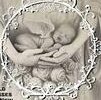Angel Gowns – A Way to Keep a Piece of Your Baby’s Memory Closer
ND Angel Gowns knit broken hearts all over the world together in love, hope and healing. Their beautiful work gives families a piece of their baby’s memory to hold onto. Every year, nearly 20% of pregnancies end in miscarriage and 24,000 babies are stillborn in the United States. That is a lot of families struggling with heartbreak. Judi Gaber is a nurse at Riley Children’s Hospital in North Dakota and has been working with these families for the past 37 years. She says losing a child is one of the most heart-wrenching things you can experience in life. She began to notice that many families didn’t have anything special to take home with their lost infants. Then she found a solution that is now in use at hospitals nationwide. Angel gowns are made out of donated wedding dresses and are used as burial outfits or keepsakes for a baby who was born too soon. Several local moms and grandmothers have taken up the task of making these special garments. They are donated to hospitals and birthing centers for families who are facing the loss of their unborn or newborn baby. The idea of repurposing a wedding dress is not new, but this particular project has grown to reach beyond just Spokane and Coeur d’Alene. Mangiaracina has since received a message from a mother in Puyallup who read her column. She and her husband lost a daughter and could relate to Sarah’s story of missing birthdays and other milestones. They decided to donate their own wedding dress and it was turned into an angel gown for her daughter’s grave site. In the months that followed, she received more messages from people all over the country who were interested in donating their dresses to be turned into angel gowns. She now has 85 gowns in various stages of completion and is supplying them to hospitals in Oregon, Texas and Montana as well. Dignity Health – St. Mary Medical Center is proud to partner with ND Angel Gowns in their effort to provide these families with a piece of their little one’s memory. Our NICU nurses are grateful to have these garments available for our tiniest patients and their families. Visit this link to learn more about the hospital and their services. A special thank you to our friends at ND Angel Gowns for bringing this heartwarming story to our attention. We can’t imagine the pain and grief that these gowns bring to families but are so happy to be able to help them in their time of need.
